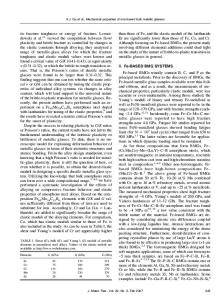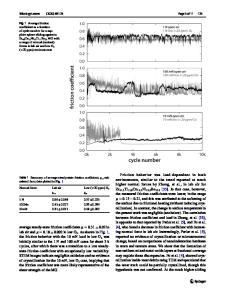Vickers hardness and compressive properties of bulk metallic glasses and nanostructure-dendrite composites
- PDF / 2,513,111 Bytes
- 7 Pages / 612 x 792 pts (letter) Page_size
- 87 Downloads / 262 Views
Zhang and Z.F. Zhanga) Shenyang National Laboratory for Materials Science, Institute of Metal Research, Chinese Academy of Sciences, Shenyang 110016, People’s Republic of China
M. Stoica Leibniz Institute for Solid State and Materials Research Dresden, Institute of Metallic Materials, D-01171 Dresden, Germany
G. He School of Materials Science and Engineering, Shanghai Jiaotong University, Shanghai 200030, People’s Republic of China
J. Eckertb) Physical Metallurgy Division, Department of Materials and Geo Sciences, Darmstadt University of Technology, D-64287 Darmstadt, Germany (Received 4 February 2005; accepted 14 April 2005)
The compressive properties and the Vickers hardness of Cu-, Fe-, Mg-, and Zr-based monolithic bulk metallic glasses (BMGs) as well as Ti-based nanostructure-dendrite composites were investigated and compared. The monolithic BMGs exhibit nearly the same yield strength y and fracture strength f but poor plasticity. The Vickers hardness HV of the monolithic BMGs follows the empirical relationship HV/3 ≈ y ≈ f. The Ti-based composites yield at a relatively low stress level (less than 850 MPa) but fail at a very high fracture stress (∼2 GPa) and exhibit a large strain hardening ability. Accordingly, the Vickers hardness HV of the Ti-based nanostructure-dendrite composites obeys the relationship y < HV/3 < f. Based on these results, the relationship between the Vickers hardness and the compressive properties of the investigated materials will be discussed by taking the yield and fracture strength (y and f ), the strain hardening exponent n, and the elastic and plastic energy stored upon deformation (␦⌭ and ␦P) into account.
I. INTRODUCTION
In 1960, an Au–Si metallic alloy with amorphous structure was first discovered.1 After that, many attempts have been devoted to amorphization of a variety of alloys.2–4 Finally, starting at the at the beginning of the 1990s and continuing since then, Zr-, Cu-, and Pd-based bulk metallic glasses and also other classes of easy glass-forming alloys were discovered and successfully a)
Address all correspondence to this author. e-mail: [email protected] b) This author was an editor of this journal during the review and decision stage. For the JMR policy on review and publication of manuscripts authored by editors, please refer to http://www.mrs .org/publications/jmr/policy.html. DOI: 10.1557/JMR.2005.0328 2632
http://journals.cambridge.org
J. Mater. Res., Vol. 20, No. 10, Oct 2005 Downloaded: 16 Mar 2015
fabricated.5–7 A large amount of investigations in the recent decade has demonstrated that bulk metallic glasses (BMGs) possess novel physical, chemical, and mechanical properties and have a large potential for a variety applications,8–10 which has created extensive interest among scientists and engineers. Normally, metallic materials with glassy structure exhibit very high strength and hardness value, a relatively low Young’s modulus, and almost perfect elastic-plastic behavior upon room temperature deformation.11,12 Therefore, the discovery of BMGs
Data Loading...











